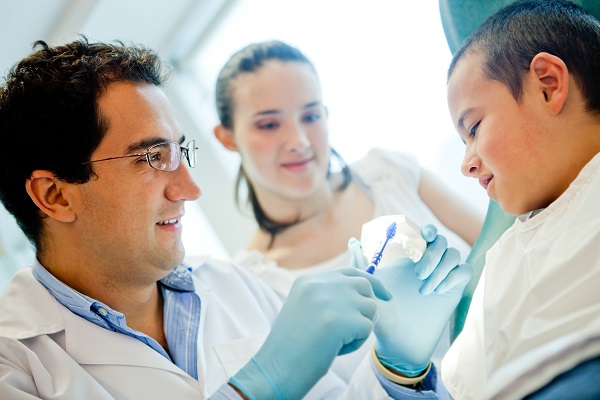Learn the Proper Way to Brush a Child’s Teeth From a Kid Friendly Dentist in Huntsville

According to a kid friendly dentist in Huntsville, it is imperative that parents begin to introduce good oral hygiene habits at an early age. That said, with all the things parents must teach their children, toothbrushing often falls by the wayside. Then there is the fact that many adults simply do not know how to teach children to properly brush their teeth. A kid friendly dentist can help with the teaching process and hold parents accountable for young patients' oral health.
When parents should introduce brushing
Many parents wait until a child's first tooth erupts to begin cleaning the mouth, but really, oral hygiene habits can and should begin as early as infancy. A mother or father can wipe a baby's mouth with a damp cloth after each feeding. Doing this helps the baby grow used to the sensation of having the mouth cleaned, so that by the time the first tooth does erupt and brushing is necessary, the baby will not reject a toothbrush.
Tips from a kid friendly dentist in Huntsville
It is not uncommon for parents to let a toddler wield a toothbrush and have at it. While it is great for parents to encourage toddlers to be independent, teeth brushing is something adults should take over until the child is school age, maybe older. Below are some tips to get parents started.
Fluoridated toothpaste and toothpaste amounts
When brushing an infant or baby's mouth, parents should use water. Parents who wish to use any type of fluoridated product should run it by a dentist first. When a child is about two years old, parents can introduce the toddler to age-appropriate toothpaste. From ages two to about five, only a pea-sized amount of toothpaste should be used.
Encouraging independence
As mentioned, a parent should brush a child's teeth for them until the child is of school age. Children are typically capable of brushing their own teeth starting between the ages of six and eight. However, parents should continue to thoroughly inspect a kid's teeth to ensure no spots are missed.
Frequency of toothbrushing
Children should brush and floss as often as adults should. That means twice a day, once in the morning and once right before bedtime. Of course, every child's oral health differs, so parents should discuss an adequate routine with the dentist.
Replacing toothbrushes
A child's toothbrush needs to be replaced as frequently as an adult's, which is every three to four months. However, if a toothbrush looks worn or frayed, it is okay to throw it out sooner. When children get colds or the flu, parents should toss out the old toothbrushes to prevent the reintroduction of germs.
Conclusion
Parenting is not easy, as many learning curves are involved. Fortunately, there are plenty of professionals who are willing and able to help, such as a kid friendly dentist in Huntsville. Parents who have questions regarding the oral health and hygiene of an infant, toddler or school-aged child should contact a family dentist.
Request an appointment here: https://www.smilesbydesignhuntsville.com or call Smiles by Design, PC at (256) 660-3233 for an appointment in our Huntsville office.
Check out what others are saying about our services on Yelp: Read our Yelp reviews.
Related Posts
Most people develop a cavity at some point in their lives, but children are especially prone to tooth decay. Dental sealants can be used to help lower the risk of getting cavities, protecting a child's teeth for many years. This supplemental treatment offers many benefits and is recommended by most dentists for virtually all children…
If you have not undergone a dental cleaning in over six months, it is time to go for a dental cleaning. Dental professionals recommend undergoing dental cleaning every six months to prevent oral issues such as tooth decay and gum disease. Due to your schedule, you might be concerned about how long the cleaning appointment…
A routine dental cleaning can prevent cavities and tooth decay. The cleanings are a protective measure that prevents plaque and tartar buildup in the hard-to-reach areas of the mouth.Just like oral health affects systemic health, dental cleanings are also beneficial to overall health. It may have something to do with the fact that the mouth…
Many people start their search for a local dentist by typing "find a dentist near me" into the search box of their internet browser. However, finding a local dentist who provides high-quality care, feels comfortable, and meets your or your family's dental needs starts with knowing what to look for. Understanding the key features of…
